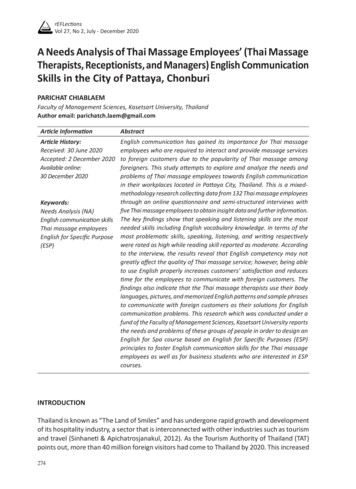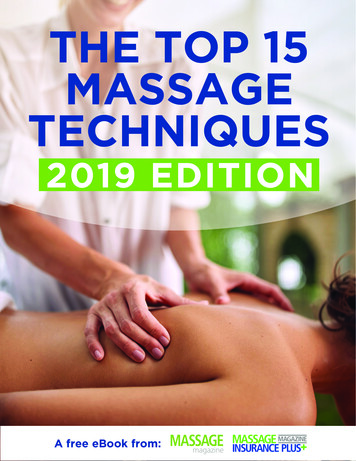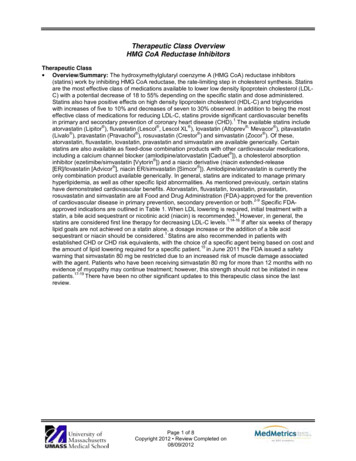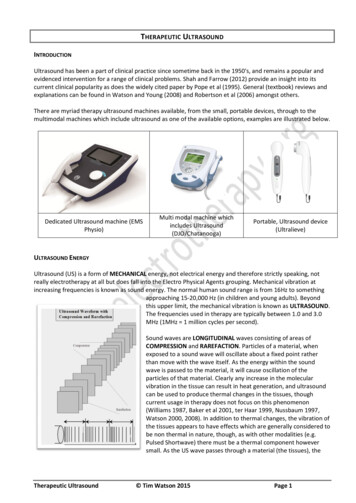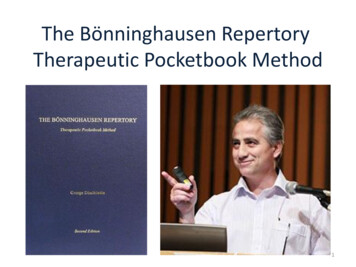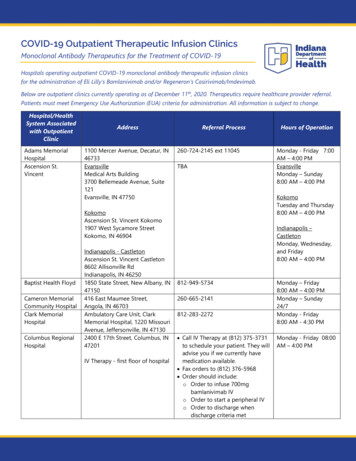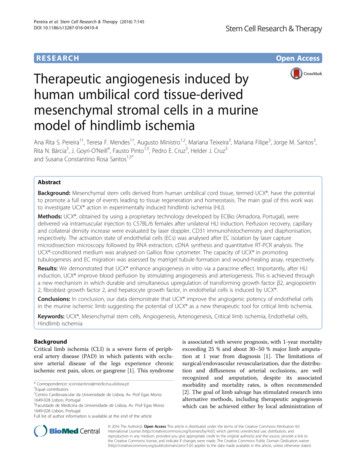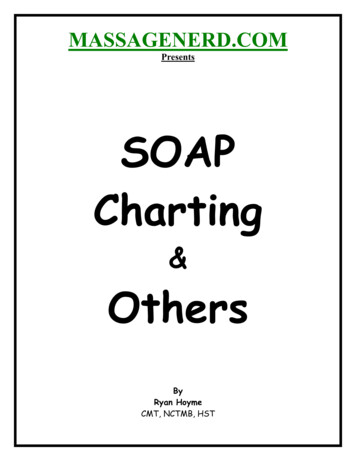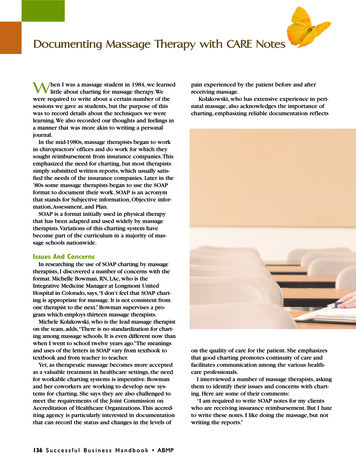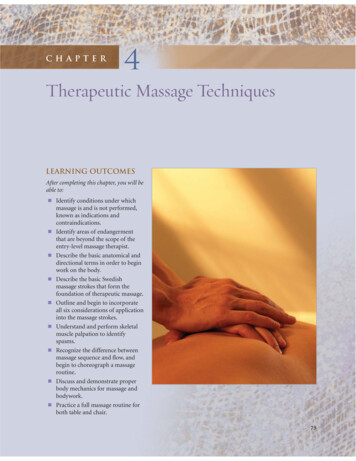
Transcription
Chapter4Therapeutic Massage TechniquesLearning OutcomesAfter completing this chapter, you will beable to: Identify conditions under whichmassage is and is not performed,known as indications andcontraindications.Identify areas of endangermentthat are beyond the scope of theentry-level massage therapist.Describe the basic anatomical anddirectional terms in order to beginwork on the body.Describe the basic Swedishmassage strokes that form thefoundation of therapeutic massage.Outline and begin to incorporateall six considerations of applicationinto the massage strokes.Understand and perform skeletalmuscle palpation to identifyspasms.Recognize the difference betweenmassage sequence and flow, andbegin to choreograph a massageroutine.Discuss and demonstrate properbody mechanics for massage andbodywork.Practice a full massage routine forboth table and chair.73
Key Termsareas of endangerment (p. 76)compression (p. 86)considerations (p. 74)contusion (p. 79)cramps (p. 79)cross-stretch (p. 86)depth or depth of pressure (p. 80)direction (p. 81)duration (p. 81)effleurage (p. 81)fine tremulous (p. 86)frequency (p. 81)friction (p. 84)hypertrophy (p. 79)indications and contraindications(p. 74)massage flow (p. 88)massage sequence (p. 88)massage therapist’s intent (p. 89)Meissner’s corpuscles (p. 80)muscle atrophy (p. 79)nerve stroke (p. 86)palpation (p. 76)petrissage (p. 83)prone (p. 88)rhythm (p. 81)rocking (p. 86)shaking (p. 86)skin rolling (p. 86)spasm (p. 78)speed of the stroke (p. 81)strains (p. 79)supine (p. 88)tapotement (p. 85)thumb presses (p. 88)vibration (p. 85)wringing (p. 86)INTRODUCTIONAll Western-oriented massage, whether it focuses on relaxation or more highly skilled work, is based onSwedish massage and the strokes first formulated by a Swedish fencing master. The term Swedish is oftenused to refer to a “light” or “relaxation” massage, whereas the term therapeutic massage denotes a morecontemporary massage that is corrective or rehabilitative.Certain considerations or elements dictate the specifics of each stroke, such as amount of pressure,the speed with which it is applied, and the length of time the stroke lasts. Your ability as a massage therapist to blend these considerations (or mechanics) with fluid movements creates a complete and fully satisfying massage that will appeal to a variety of clients.For the entry-level massage therapist, general guidelines specify conditions where massage is and isnot warranted, commonly known as indications and contraindications. Further, there are areas of thebody known as areas of endangerment that require advanced training and are, therefore, not within thescope of this text. For safety reasons, these precautions must be understood early on in the therapist’straining. However, all massage therapists should follow the old adage, “When in doubt, don’t” and themedical credo “Do no harm.”Indications andContraindicationsMassage therapists often find themselves in situations where they must ask the seemingly simple question: “Can this person receive a massage at this time?” There are a fewguidelines to follow that clearly state instances in which, or conditions where, massageis recommended (indicated) and instances in which, or conditions where, massage isnot recommended (contraindicated).T E C H N I Q U E E M P H A S I S To complicate matters further, some conditions arelocal contraindications (so the rest of the body may receive massage), while someconditions may require a different massage modality.Below are basic guidelines that will aid you in your decision. For an in-depth lookat possible ramifications of working with clients taking medications, see chapter 22.IndicationsAs mentioned in the Introduction and Overview, there are numerous benefits to receiving a massage and just as many conditions for which massage is indicated. First and74Part I Basic Concepts of Therapeutic Massage and Bodyworkwww.mhhe.com
foremost, circulatory massage, such as Swedish massage, increases circulation. The individual cells of the body depend on an abundant supply of blood and lymph. Thesefluids supply nutrients and oxygen to the body as well as carry away wastes and toxins.So, massage simply helps promote overall good health.Massage facilitates the smooth flow of energy and communication among the cardiovascular, digestive, urinary, respiratory, lymphatic, and nervous systems—creatinghomeostasis (constancy and balance in the body). With reference to the integumentarysystem, massage can often enhance skin condition. Massage directly improves the function of the oil and sweat glands that keep the skin lubricated, clean, and cooled. Tough,inflexible skin can become softer and more supple following massage. A healthier, moreyouthful appearance may be the result.Massage also aids recovery from soft tissue injuries, such as sprains and strains. Thegrowth and repair of tissues are accelerated by efficient circulation in the injured areasand appropriate stimulation of the healing tissues. Therefore, massage therapy can often help accelerate and improve recovery as well as reduce discomfort from such injuries (see chapter 13).Finally, massage can have a calming effect on people who are high-strung (“TypeA” personalities) and people who have become dependent on pharmaceuticals or alcohol for rest and relaxation (although it should never replace physician-prescribed medications for diagnosed mental or emotional disorders). Massage balances the nervoussystem by soothing or stimulating nerves and neural pathways, depending on which effect is needed by the individual at the time of the massage.Common afflictions such as muscle tightness and tension, insomnia, and tensionheadache caused by stress; spasms and cramps (charley horses) resulting from sportsactivities; digestive disorders (including constipation and spastic colon) encouraged bya hectic lifestyle; arthritis, asthma, fibromyalgia, sinusitis, and temporomandibularjoint dysfunction caused by certain pathologies; carpal tunnel syndrome and thoracicoutlet syndrome caused by repetitive motions; and postural imbalances caused by temporary conditions such as pregnancy or genetic conditions such as scoliosis all warrantmassage (see Introduction and Overview, and chapter 5). Generally, anytime a massagewill be beneficial to the person and no underlying causes of concern such as disease orcirculatory problems exist, it is considered an indication.ContraindicationsContraindications may be general or local, specific to certain modalities, or determinedby medication use. Circulatory massage is considered a total contraindication in situations in which any modification, modality, or location would result in unsafe conditions. A circulatory massage is defined as any massage modality, such as Swedish, thatdirectly moves blood and lymph through the body, as opposed to an acupressure massage that works on meridians, and indirectly affects the blood and lymph system.Anytime a client has a severe condition (e.g., severe insulin-dependent diabetes orhigh blood pressure), total or full-body circulatory massage is contraindicated. Edemadue to any heart, lung, liver, or kidney dysfunction is a contraindication for massage. Theresponse to touch (reflex effect on nervous system) could make the disease worse. In cardiovascular diseases, massage could dislodge a thrombus (blood clot), resulting in anembolus (floating blood clot) and causing heart attack or stroke. Abnormally high bodytemperature, often an indication of acute infection, is a contraindication for massage.Modifications to massage such as refraining from working on a certain area (local)can be made to allow massage to the rest of the body. For example, you should not massage distal to (or below) varicose veins so you do not further damage already compromised veins, but you may proceed with massage on the rest of the body (or massageproximal to, above, the veins). Never perform massage over open wounds, lesions, orother potentially infectious sores.Many grey areas exist in which the therapist must draw on training and practicalexperience to make an educated decision as to whether or not the client may receive awww.mhhe.comChapter 4 Therapeutic Massage Techniques75
massage. In some cases, it might be a quality of life issue. A terminally ill client, as in thecase of a cancer or AIDS patient, would benefit from the touch of a skilled and compassionate therapist. In other cases, under a doctor’s guidance, a client may receive a spot—or area-specific—massage to alleviate pain. If you question whether or not you shouldmassage a client or specific area, do not do so until you have further clarification fromanother health care professional. It is far better to lose one massage than cause harm toa client. If your gut says no, listen!Depending on the situation, you may be able to switch to another modality, suchas Thai massage or Reiki. For example women who are breast cancer survivors may benefit from Thai massage or shiatsu. A small amount of localized acupressure massage andgentle stretching can be both relaxing and balancing for women emerging from a verydifficult time. Further, energy work can be an excellent alternative to circulatory massage. Again, conditions that are contraindicated for circulatory full-body massage (suchas lupus) may not be compromised by other modalities.A client on anti-inflammatories (ibuprofen) or analgesics (aspirin and acetaminophen) may not be able to accurately assess pain levels during a massage. A client takingmuscle relaxants will have an altered sense of stretch response, prohibiting very deepwork. Circulatory massage is contraindicated for any client on an anticoagulant. Medications that slow the clotting process would be compromised by massage that increasesblood flow.Areas ofEndangermentAreas of endangerment are areas of the body where no pressure or no deep applicationof pressure is recommended because of underlying structures such as nerves, arteries,veins, and vital organs. Most areas of endangerment are located at joints, such as theback of the knee (popliteal region) or inside of the elbow (cubital region). There are afew instances where application of pressure to these areas is acceptable; however, thisapplication requires highly specific training that does not fall within the entry-levelmassage therapist’s scope of practice. The Think About It in this chapter lists areas ofendangerment on the body. Figure 4.1 illustrates the location of these sites.DirectionalTermsBefore working on the body, a complete understanding of body regions and directionalterms is necessary. The body is discussed as it is held in anatomical position: standingerect with head and feet forward, arms at sides with palms facing forward. The extremities refer to the hands, arms, feet, and legs. The torso (or trunk) is the body from thechest cavity to the abdominal cavity, minus the head and neck. Medial refers to towardthe midline of the body, while lateral refers to away from the midline. In any circulatorymassage, work is done centripetally, which means toward the heart. See chapter 6 for adetailed discussion of directional terms. Also, begin to familiarize yourself with themuscles and their location and bony landmarks by reading chapters 8 and 9.The Art ofSkeletal MusclePalpationSimply stated, palpation is the art of observing with your eyes, touching with yourhands, and identifying with your eyes and hands. When you palpate, you are using theart of touch to evaluate the body. Although there are many types of body palpation, wewill focus on accessing the skeletal muscle structure and function. The purpose of themassage therapist’s initial palpation evaluation is to determine whether skeletal muscles and their connective tissue coverings are functioning normally or abnormally. Thiswill greatly assist you in determining the type of massage strokes—as well as theamount of pressure applied with the strokes—that are best suited to your client.Detailed discussions of anatomy, physiology, and kinesiology can be found in part2 of this text, but for our purposes here, a brief overview of anatomy and physiology re-76Part I Basic Concepts of Therapeutic Massage and Bodyworkwww.mhhe.com
3 endangerment areas of the neck1 Inferior to ear2 Anterior3 Posterior(a)Figure 4.1Abdominal aortaAxilla (armpit)Medial brachium(b)www.mhhe.com(a) Areas of endangermentin the supine position.(b) Areas of endangermentin the prone position.Femoral triangle2 endangerment areas of the elbow1 Cubital (anterior)2 Ulnar notch (funny bone)Popliteal fossa(Back) kidneysChapter 4 Therapeutic Massage Techniques77
Think About ItAreas of Endangerment1. Inferior to the earLocation: notch posterior to the ramus of the mandibleStructure of concern: facial nerve, external carotid artery, styloid process2. Anterior triangle of the neckLocation: borders formed by SCM, trachea, and mandibleStructures of concern: carotid artery, jugular vein, vagus nerve3. Posterior triangle of the neckLocation: borders formed by SCM, trapezius, and clavicleStructures of concern: brachial plexus, subclavian artery, jugular, brachiocephalic vein4. AxillaLocation: armpitStructures of concern: axillary, median, musculocutaneous, and ulnar nerves; axillaryartery5. Medial brachiumLocation: upper inner arm between biceps and tricepsStructures of concern: ulnar, musculocutaneous, and median nerves; superior ulnarartery, brachial artery, basilic vein6. Cubital area of the elbowLocation: anterior bend of the elbowStructures of concern: median nerve, radial and ulnar arteries, median cubital vein7. Ulnar notch of the elbowLocation: “funny bone” between the medial epicondyle of the humerus and theolecranon process of the ulnaStructures of concern: ulnar nerve8. Femoral triangleLocation: bordered by the sartorius muscle, adductor longus, and inguinal ligamentStructures of concern: femoral nerve, femoral artery, femoral vein, great saphenous vein9. Popliteal fossaLoca
Therapeutic Massage Techniques Learning Outcomes After completing this chapter, you will be able to: Identify conditions under which massage is and is not performed, known as indications and contraindications. Identify areas of endangerment that are beyond the scope of the entry-level massage therapist. Describe the basic anatomical and directional terms in order to begin work on the body .File Size: 2MBPage Count: 40
